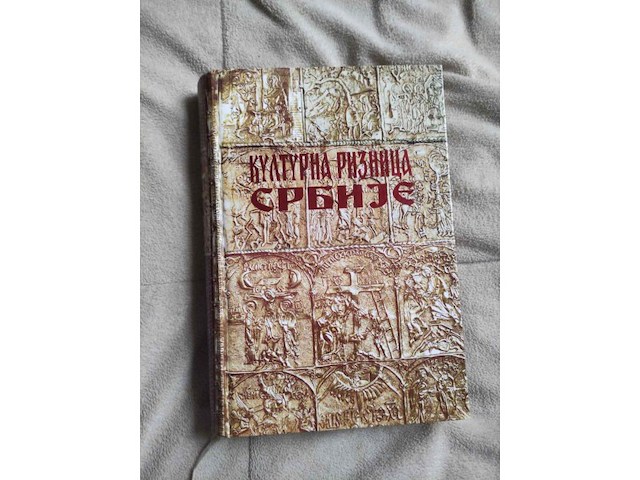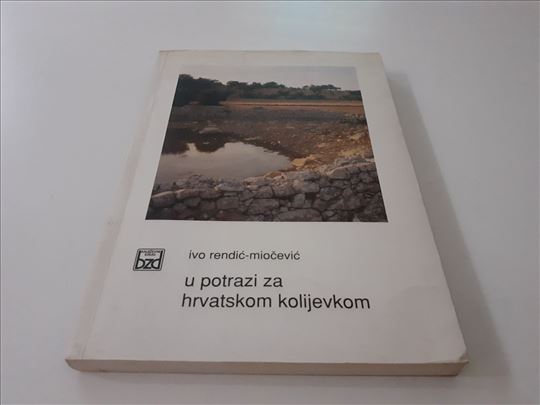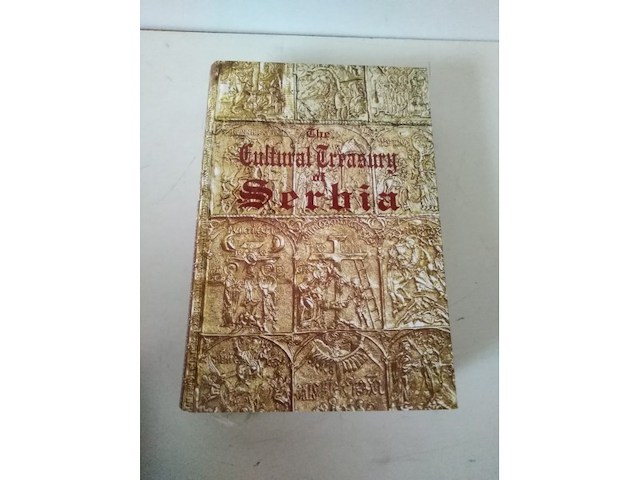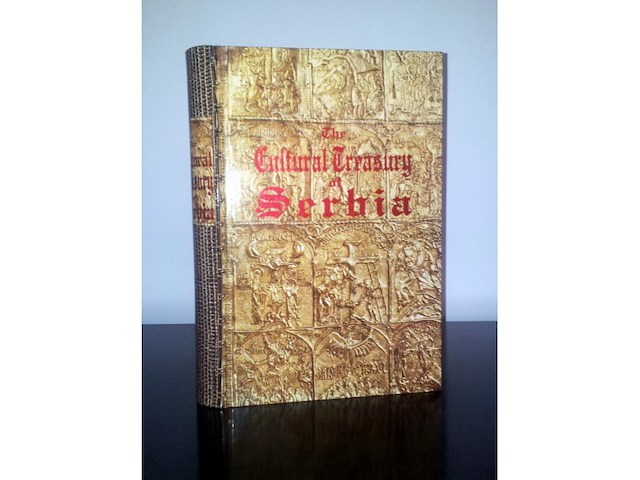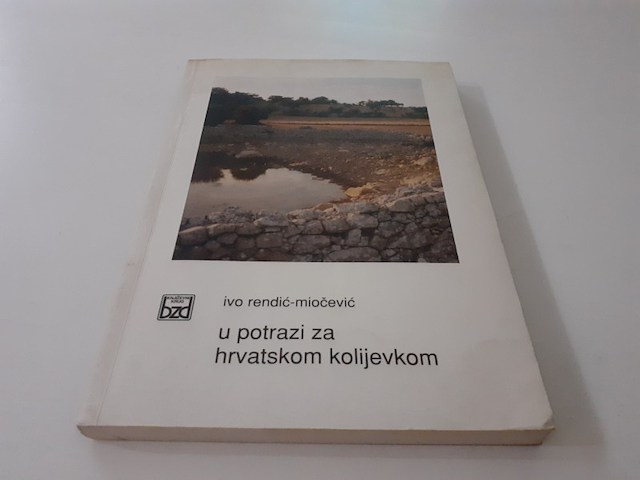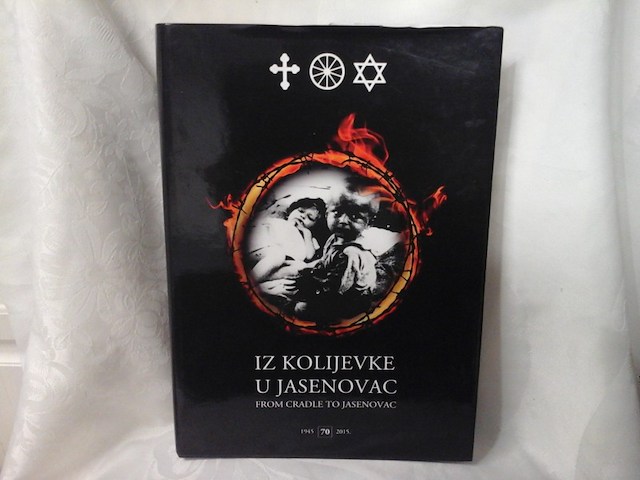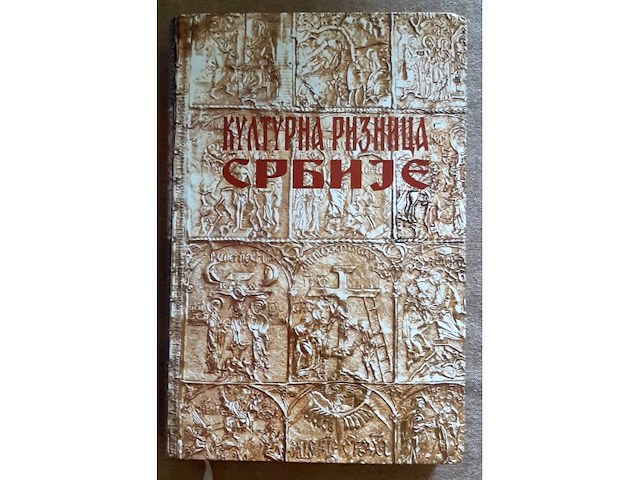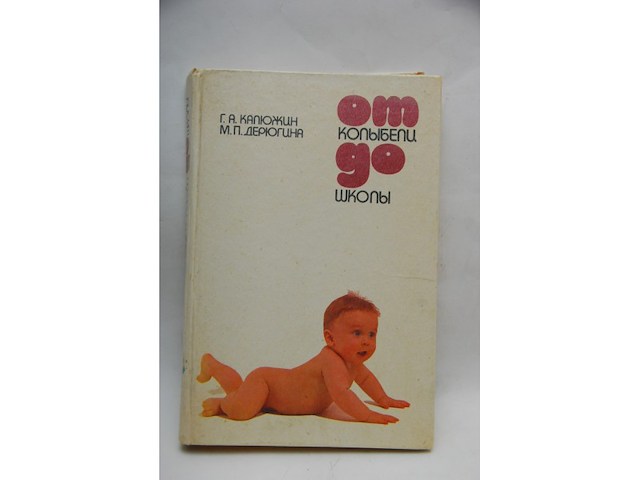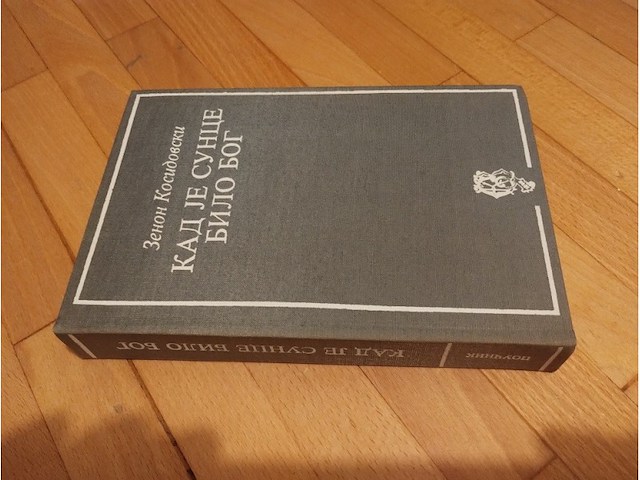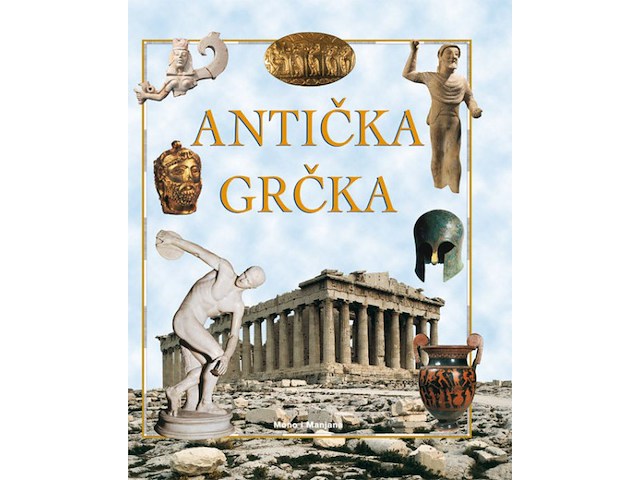Pratite promene cene putem maila
- Da bi dobijali obaveštenja o promeni cene potrebno je da kliknete Prati oglas dugme koje se nalazi na dnu svakog oglasa i unesete Vašu mail adresu.
26-50 od 139 rezultata
Prati pretragu "Kolevka "
Vi se opustite, Gogi će Vas obavestiti kad pronađe nove oglase za tražene ključne reči.
Gogi će vas obavestiti kada pronađe nove oglase.
Režim promene aktivan!
Upravo ste u režimu promene sačuvane pretrage za frazu .
Možete da promenite frazu ili filtere i sačuvate trenutno stanje
Aktivni filteri
-
Tag
Stručna literatura
Knjiga je dobro očuvana. ,,Kulturna istorija Srbije duga je i složena. Njeni počeci, koji sežu u ledeno doba, samo se naslućuju, ali već od početka VII milenijuma pre n. e. Njeni osnovni tokovi postaju jasniji, a sadržaji se bogate mnogim značajnim ostvarenjima. Do vremena doseljenja Slovena teritorija Srbije obeležavala je u nekoliko mahova središte civilizovanog sveta, a često je bila i kolevka ideja koje su presudno uticale na kulturnu, privrednu i političku istoriju Evrope.``
-
Kolekcionarstvo i umetnost chevron_right Knjige
U potrazi za hrvatskom kolijevkom Rendić - Miočević, Ivo (Retracing the past to the cradle Croatian history) Autori Rendić - Miočević, Ivo Vrsta, podvrsta i kategorija knjige Autorske knjige, monografija, znanstvena Izdavač Književni krug Grad Split Godina 2000 Stranica 238 Ključne riječi nova metodologija; ilirik; hrvatska etnogeneza; država-vladavina; simboli; izmjena Nad-ja; dugotrajni srednji vijek (new methodology; Illyricum; Croatian ethnogenesis; state-rule; symbols; new super-ego; long duration of medieval era) Sažetak Prvo poglavlje ističe metodološke probleme znanosti o povijesti i raspravlja o Iliriku ( ne o Balkanu ) kao povijesnom okviru hrvatske etnogeneze. Drugo poglavlje raspravlja o stratumima u hrvatskoj etnogenezi i o nasljeđu koje su Hrvati primili od starosjedilaca. U trećem poglavlju opisuje se stara hrvatska država kao vladavina, te se traže uzroci nasilja o kojima svjedoče izvori. Primjenom frojdovskih teorija objašnjava se nasilje u krvno povezanim zajednicama. U četvrtom poglavlju objašnjava se simbolika starih hrvatskih spomenika, a u petom na temelju Ljetopisa popa Dukljanina istražuje se stara ideologija koja se ponavlja i u narodnim pjesmama iz doba osmanske prevlasti. Pomoću ideologije autor definira sindrom Kraljevića Marka. U sedmom završnom poglavlju ističe se ideja o bogatom i dugotrajnom srednjem vijeku.
Autor: Jovan Janićijević Povez: tvrd Format: 16x24 Br. strana: 644 u odličnom stanju Kulturna istorija Srbije duga je i složena. Njeni počeci, koji sežu u ledeno doba, samo se naslućuju, ali već od početka VII milenijuma pre n. e. Njeni osnovni tokovi postaju jasniji, a sadržaji se bogate mnogim značajnim ostvarenjima. Do vremena doseljenja Slovena teritorija Srbije obeležavala je u nekoliko mahova središte civilizovanog sveta, a često je bila i kolevka ideja koje su presudno uticale na kulturnu, privrednu i političku istoriju Evrope.
Kulturna istorija Srbije duga je i složena. Njeni počeci, koji sežu u ledeno doba, samo se naslućuju, ali već od početka VII milenijuma pre n. e. Njeni osnovni tokovi postaju jasniji, a sadržaji se bogate mnogim značajnim ostvarenjima. Do vremena doseljenja Slovena teritorija Srbije obeležavala je u nekoliko mahova središte civilizovanog sveta, a često je bila i kolevka ideja koje su presudno uticale na kulturnu, privrednu i političku istoriju Evrope. KNJIGA JE KAO NOVA,TVRDE KORICE,MASTAN PAPIR,641 STRANICA
Autor: Jovan Janićijević Povez: tvrd Format: 16x24 Br. strana: 644 Kulturna istorija Srbije duga je i složena. Njeni počeci, koji sežu u ledeno doba, samo se naslućuju, ali već od početka VII milenijuma pre n. e. Njeni osnovni tokovi postaju jasniji, a sadržaji se bogate mnogim značajnim ostvarenjima. Do vremena doseljenja Slovena teritorija Srbije obeležavala je u nekoliko mahova središte civilizovanog sveta, a često je bila i kolevka ideja koje su presudno uticale na kulturnu, privrednu i političku istoriju Evrope.
Zašto Srbi nestaju - Biljana S.Spasić Biljana S.Spasić Zašto Srbi nestaju Izdavac - Autorsko Izdanje Godina - Kragujevac 2002. deveto dopunjeno izdanje Povez - Brosiran Broj strana - 221 Pismo - Cirilica Format - 20x14 Vrlo dobro ocuvana knjiga. Sadržaj je na dodatnim slikama.na 1. strani napisana posveta. Ako Vas nešto zanima, slobodno pošaljite poruku. Ovo je najjeftiniji primerak na sajtu na dan postavljanja! POGLEDAJTE I OSTALE predmete KOJE PRODAJEM POPUST NA VIŠE KUPLJENIH PREDMETA, PITAJTE! KLIKNITE NA LINK http://www.kupindo.com/Clan/zambezi/SpisakPredmeta
Godina izdanja: 2002 Autor: Domaći Jezik: Engleski Oblast: Istorija i Umetnost Autor: Jovan Janićijević Povez: tvrd Format: 16x24 Br. strana: 644 Kulturna istorija Srbije duga je i složena. Njeni počeci, koji sežu u ledeno doba, samo se naslućuju, ali već od početka VII milenijuma pre n. e. Njeni osnovni tokovi postaju jasniji, a sadržaji se bogate mnogim značajnim ostvarenjima. Do vremena doseljenja Slovena teritorija Srbije obeležavala je u nekoliko mahova središte civilizovanog sveta, a često je bila i kolevka ideja koje su presudno uticale na kulturnu, privrednu i političku istoriju Evrope.
Knjige u dobrom stanju! Korice kao na fotografijama, unutrasnjost u dobrom i urednom stanju! Na svakoj knjizi trag korektora, posto je bio potpis prethodnog vlasnika! Raška Umetničko-istoriska revija. Urednik Mirko Cvetkov. Knj. I-III. Str. 10+ sl. 9, 39+sl. 9, 56+ sl. 10. Beograd, 1934-1937 likovna umetnost balkanskih zemalja iz oblasti srednjovekovnog srpskog crkvenog zidnog slikarstva slike u boji: -GLAVA ISUSA HRISTA IZ CRKVE SV SOFIJE U OHRIDU XI VEK -LIK BOGORODICE IZ CRKVE SELA VODNA (NEREZI) XII VEK -GLAVA ANDJELA IZ MANASTIRA MILEŠEVE XIII VEK ... I TAKO OKO 28 ILUSTRACIJA veliki format 34 cm Cetvorojezicno izdanje, Srb, Eng, Fra, Nem. Kod knjige br 1 prednja korica se odvojila, nista strasno, unutrasnjost svih knjiga u super stanju! Рашка је била једна од српских средњовековних држава, са средиштем у Старом Расу, недалеко од данашњег Новог Пазара. Током 11. и 12. века обухватала је југозападне делове данашње Србије, североисточне делове данашње Црне Горе и најисточније делове данашње Босне и Херцеговине. Рашки владари су носили титулу великих жупана. Успон Рашке започео је крајем 11. века, за време владавине великог жупана Вукана који је водио успешне ратове против Византије. Рашки владари су одржавали блиске везе са владарима суседне српске краљевине Дукље. Рашки велики жупан Стефан Немања је у другој половини 12. века постао најмоћнији међу српским владарима створивши јединствену државу која је обухватала скоро све српске земље. Из Рашке државе развило се под Немањиним потомцима средњовековно Српско краљевство у 13. веку, а потом и Српско царство у 14. веку. Само име Расија (Рашка) први пут се помиње 1189. године. Од тада Млечани, Немци и Мађари до 18. века Србију називају Расција, а Србе Рацима, Расцијанима, Раиценима и слично. Име Рашка је данас сачувано у имену Рашког округа у Србији, а територија некадашње Рашке је данас позната под географским именима Рашка област. Архангел Михаило је заштитник лозе Немањића. Према наводима из дела „De administrando imperio”, Србија је у 9. веку обухватала градове: Достиника (или Достиник, негде између данашње Сјенице и Пријепоља) Чернавуск (??Црна Стена??, у близини Милешеве) Међурјечје (изнад ушћа Праче у Дрину код Горажда) Дрежник (изнад Великог Рзава или Пљевља) Лесник (на Дрини) Салинес (тј. Соли, данашња Тузла) и област Босну са градовима: Катера (тј. Которац у данашњем Источном Сарајеву) Десник (тј. Сутјеска на Трстивници) док је утврђени Рас са жупом Рашком чинио њену источну границу. Рашка је историјски била део Србије, али због значаја који су Немањићи као владари оставили у историји Срба термини Рашка и Србија односно Рашанин и Србин током историје постоје као синоними јер је Рашка колевка Српског царства и данашње Србије. Треба разликовати првобитну Србију односно прву српску државу коју су створили Властимировићи у 9. веку и која је обухватала све српске области на Балканском полуострву са једне стране и Рашку односно трећу српску државу са друге стране. Колевка прве српске државе налазила се на простору између река Таре, Лима и Дрине, за разлику од Рашке која се налази нешто источније. Грубу границу ове две области чини вододелница река Лима и Рашке. Према томе Рашка је колевка Србије, али и колевка српске државности односно Срба на Балканском полуострву.
U potrazi za hrvatskom kolijevkom Rendić - Miočević, Ivo (Retracing the past to the cradle Croatian history) Lib3 Rendić - Miočević, Ivo Vrsta, podvrsta i kategorija knjige Autorske knjige, monografija, znanstvena Izdavač Književni krug Grad Split Godina 2000 Stranica 238 Ključne riječi nova metodologija; ilirik; hrvatska etnogeneza; država-vladavina; simboli; izmjena Nad-ja; dugotrajni srednji vijek (new methodology; Illyricum; Croatian ethnogenesis; state-rule; symbols; new super-ego; long duration of medieval era) Sažetak Prvo poglavlje ističe metodološke probleme znanosti o povijesti i raspravlja o Iliriku ( ne o Balkanu ) kao povijesnom okviru hrvatske etnogeneze. Drugo poglavlje raspravlja o stratumima u hrvatskoj etnogenezi i o nasljeđu koje su Hrvati primili od starosjedilaca. U trećem poglavlju opisuje se stara hrvatska država kao vladavina, te se traže uzroci nasilja o kojima svjedoče izvori. Primjenom frojdovskih teorija objašnjava se nasilje u krvno povezanim zajednicama. U četvrtom poglavlju objašnjava se simbolika starih hrvatskih spomenika, a u petom na temelju Ljetopisa popa Dukljanina istražuje se stara ideologija koja se ponavlja i u narodnim pjesmama iz doba osmanske prevlasti. Pomoću ideologije autor definira sindrom Kraljevića Marka. U sedmom završnom poglavlju ističe se ideja o bogatom i dugotrajnom srednjem vijeku.ABSTRACT I. Methodological problems The arrival of the Croats places them geographically within the framework of the `Balkans`, but this political connotation imposed by the West at the beginning of the 19th century is not based on serious criteria. The most appropriate term for a spatial definition of Croatian history (as well as the history of other Southern Slavic peoples) is certainly the old term Illyricum. Within the boundaries of this area, the Southern Slavic peoples were generally moulded and here we can follow the `continual` processes from time immemorial to the present. In the aftermath of the migrations, within the Illyrian blood-tied society, there were bloody battles accompanied by psychopathological symptoms e.g. paranoia and projection identification, to establish control and wield power. Then, undoubtedly, certain archetypes with `continual` impact emerged, fuelling bloodshed up to the present! As both written and archeological sources clearly point to the unconscious of present-day Croats` ancestors who wove the Croatian cradle, we should look to psychoanalysis to help us explain the Croatian genesis. In this context, the psychoanalytical term `matrix` (basic substance, source, womb, woof) can be of considerable assistance. This `matrix` is, in fact, a `hypothetical web` (cobweb or membrane) of communication and relationship in a given group. In various ways, the family, religious fraternity and monastery had the strongest impact and were the pillars of the early Croatian matrix. Today, historical science converges with many other disciplines (sociology, economy etc.). In striving to uncover all facets of human behaviour, it needs to ally itself more with psychology and knowledge based on Freud`s theories. `Psychohistory` certainly should form part of an interdisciplinary approach to a historical analysis and its significance is all-encompassing in the study of mentality. In researching old Croatian history, the interdisciplinary path should therefore be trod. Initially, there will be some sidetracking but, finally, an authentic area of research will be reached. II The Croatian ethnogenesis in Illyricum: Steering towards scientific solutions The ethnogenesis of Croatians is one of the most perplexing questions of early Middle Ages in central and south-east Europe, and is ascribed to the Slavs, Iranians or Avars, begins with the great migrations or regional development and is explained by Avar or Frank influence. In reflecting on the Croatian ethnogenesis, some hypotheses, which are not based on evidence, have been transformed into ideology. Initially, in the great migratory waves, those peoples have a polyethnic structureand it is impossible to imagine that the Croats to the South would have arrived as a `pure` race. Moreover, the mistaken romantic notion of identifying old Croats with the modern Croatian nation should be rejected. Inter-marriage, wars and migrations plus religious conversions considerably changed the ethnic situation from the first centuries following the migrations. Shortly before a modern integration of the nation, this picture alters significantly. There are diverse opinions about who, in fact, the Croats are (social designations, the leading class in the Avar khaganate, mercantile political groups etc.) but there is no definitive solution. The Illyrian-Romanic and, certainly, the former pre-Illyric Mediterranean strata left indelible traces in the Croatian ethnogenesis. The Croats assimilated their indigenous culture which had been deposited for centuries. They organically assimilated the Classical period and its culture and made it their own and they alone, of all southern Slavic peoples, have a continuity of urban civilization. It is an indisputable fact that there has been a continuity of culture in the Illyricum area from time immemorial through the Classical period, on to early medieval Croatian era and up to the present (national costumes, music, customs, continuity of settlement, navigation etc.). Apart from irrefutable evidence of a native component in the Croatian ethnogenesis, there are others which relate to social organization and customs (`ideology`, patriarchal society, tribes, mentality, symbols, myths etc.). In discussions on native components in the Croatian ethnogenesis, anthropological research must be taken into consideration. It has been proved that there is an anthropological continuity in the area of Roman Dalmatia from Roman times to the late Middle Ages.If anthropological research is added to linguistic analyses of onomastic and toponomastic material which point to the fact that a very great number of present-day names have been inherited from the Illyrians or even older inhabitants, our picture of the Croatian ethnogenesis will be complete. An analysis of the character of the Liburnian, Delmatian, Ardayan and other Illyrian societies which we know little about, show that the influence of the indigenous population on the newcomers was varied. This fact must be respected in all discussions on the Croatian ethnogenesis. The Croatian ethnogenesis on the Illyrian area represents a long process. III. The Croatian state - rule ine Europe during `wilde times`. During Frank domination those lands, which had retained the old name of Roman provinces became the boundaries of new government organization. In the middle of the 10th century, Croats ruled the territory from Drave to the Adriatic and from Raša in the west to Cetina in the east, later expanding to include the Neretva region. This unique rule was called `Regnum Chroatorum`. Outside that rule was Byzantine Dalmatia which had `shrunk` to the towns of Zadar, Trogir, Split, Dubrovnik and Kotor with the islands Krk, Rab and Cres. A Croatian medieval state had already existed in the 9th century. However, along with other contemporary European states of the time, it did not represent any special feature but in reality encompassed state rule (principatus, ducatus, regnum). That rule had nothing in common with the people ; it embraced only the ruler and his `state apparatus` represented by the social structure based on blood ties. Medieval states did not have sovereignty as we know it today and reigns were considered provincial governments or rules of Roman State vassals. From embryonic states, characterised by a duchy`s armed units, the medieval state and its apparatus emerged. For medieval Croatia, the notion `rule` or `governing` is the best example. In spite of the `Croatian bloody line`, early Croatian history obviously portrays signs of superego transformation which is demonstrated in the construction of `freestyle` small churches, testifying to the entry of Croats into European culture. Architecture and pre-Romanic art in general, together with Croatian tri-lingual and tri-alphabetical literature which surface in the early Croatian centuries, bear witness to the gradual creation of Brodel`s stable and sagacious Dalmatian world which is constructed patiently and compactly, encompassing a hierarchy and discipline within. For centuries in Illyrcum, a rapacious type of economy is observed i.e. looting and pillaging, accompanied by cruelty and decapitation. This type of pillaging can be observed also in earlier Croatian sources. Within the framework of a pillaged economy in a patriarchal tribal community, from the time of the old Croatian government and the following two centuries, a long-standing conflict, characteristic for the Mediterranean, can be discerned. This is the confrontation between the coast with its organized life and the patriarchal violent hinterland craving for the wealth along the coast, accumulated painstakingly over centuries. The old Croatian society whose base was the extended family-home, is characterised in fact by a patrilinear inheritance and the subordinate position of women. Archeological research offers firm evidence of their difficult position in old Croatian society. In a patriarchal tribal family, the father symbolizes authority and it is he who inflicts physical punishment on his wife and children. An Oedipal clash develops from such relationships ; the ego and superego of the child are not built on the model of the parents but on the superego of the parents. Superego has always been impregnated with the same contents and becomes the carrier of tradition and values over time. Blood ties, forming the base of tribal compactness, become a system of kinship which maintains a high level of cohesion but, simultaneously, in its conservatism it impedes development. There is conflict between the son and his authoritarian father and being unable to eliminate him, he externalizes his aggression towards others. Namely, the deep-seated desire to destroy the loathsome figure of the father can lead him to kill his adversary who has become a substitute for the father. `Daily violence` in the medieval Croatian state offers ample proof of the externalization of aggression. One of the more important issues which has been neglected in Croatian historiography is the question of marriage and its subjection to church canonscousins, and those incestuous ties, contrary to Church canons, were based on the organisation of a Croatian great family. The Church, obviously, had little success in introducing Roman and canon law into the Croatian area. Transferring that task to the Croatian rulers, who would have overseen the organisation of the family as a social nucleus, would have had grave repercussions. This was the pattern, requested by the Pope, then prevailing in western Europe. Interfering in old marriage customs could have triggered the old conflicts between the kinship structure and rulers. The unresolved status of the family probably embittered the lives of widows and orphans in Croatia as well as the rest of Europe. The ruler was he who, in the West, accepted the responsibility of protecting the widows, and sources of Croatian history (inscription of queen Jelena, pic. 5 and Zvonimir`s commitment) lead us to believe that the same function of protecting the helpless was undertaken by Croatian rulers, obviously under pressure from Rome. However, the complex problem of organising the Croatian family, i.e. in the sense of its canonization, which was a pre-requisite of Roman rule in the area, could not be solved by Trpimirović dynastic rulers. The geographical location of Illyricum with the Adriatic coastline had already in Classical times drawn people together and, over time, this region acquired significance as a transit area. Croats again, in the traditions of Classical times, rapidly integrated into a world which was once more opening up and this area, following migration, would become a significant communicational crossroads between East and West. IV. Symbolism and cults The Benedictines played a remarkable cultural role in early medieval Europe and certainly also in Croatia. Among other things, it should be pointed out that they were mainly interested in space and time. In that quest, it is worth seeking the significant dimensions of buildings and artistic expression in general. Pre-Romanic churches were built on the basis of amazing knowledge of mathematics, geometry and astronomy. The author explins the signification of laticed decoration and other symbols (a Croatian ruler relief figure, pagan elements into Christianity, inventary found in graves etc.). Explanation of the symbols and an acquaintance with the cults are indispensable components in interpreting the early Croatian matrix-cradle. V. Ideology In shedding light on the ideology of old Croatian societies, research on meaningful dimensions of the priest Dukljanin`s Chronicle (Sclavorum Regnum - Kingdom of the Slavs) written at the end of the 12th century can be of assistance. It describes a society that had changed little in comparison to the previous centuries. It is this Chronicle, filled with motifs of violence, which becomes an excellent source for uncovering the old ideologies of the Croatian patriarchal society. That ideology very clearly points to the Prince Mark syndrome (later observed in national songs during Turkish rule) which is synonymous with symptoms such as projections, fear of castration, paranoia, narcissism, traumatic neurosis and externalization of aggression. VI. Construction of a new super-ego in Croats According to Sigismund Freud`s theory, super-ego forms part of the personality which contains a codex of moral norms and behaviour. The child`s super-ego is not formed in accordance with the parent`s picture but in accordance with the parent`s super-ego, becoming an advocate of tradition and value judgements down through many generations. Of course, the super-ego of the Croatian warriors, following migration, shifts under the influence of various contents offered by the new environment. In this `melting pot` of diverse impacts, new social norms of behaviour were forged. Researching early Croatian culture and remains from ancient times provides us with the tools for outlining (not for defining completely) a shifting super- An alteration in the super-ego of the Croats had, for centuries, been vigorously expressed but the tragic events around 1500 AD changed that. Here over a wide area, the old indigenous Čakavian population disappeared, and the ensuing repercussions caused the Prince Mark syndrome to prevail in Croats in the patriarchal area where tribal fears, anxieties, paranoia and projections have lasted up to the present. VII Conclusion Completion of a rich croatian medieval era The previous analysis provided us with an outline of an original Croatian cradle-matrix in the area of the medieval Croatian state - rule. The cradle is based on the Croatian kinship system as well as the Classical-Christian civilization. Research should be pursued, completing the outline with many other facts which various sciences (anthropology, musicology, ethnology etc.) can provide. This research has shown that the Croatian cradle-matrix is characterised from one side by violence grounded in the unconscious of the kinship society and, from the other side, despite violence, positive shifts in the super-ego can be discerned. A leading role in the early matrix is played by the Catholic Church which brings faith and Classical traditions to the Croats. The early Croatian matrix has a continuity up to the present. The Turkish invasion triggered a breakdown in the matrix in the traditional patriarchal areas (Lika, Dalmatian hinterland, Bosna and Hercegovina) thwarting them in their efforts to suppress projections, fears, paranoia and traumatic neuroses. The term medieval in Croatian history could be extended, without any derogatory thinking, up to the present time. Medieval Croatia was a time where a wonderful, original culture of a people, whose national principle had primarily developed as a cultural idea, ended, if we accept Le Goff`s idea, only in our times when an independent Croatia created the possibility for liberating the primary matrix from psychopatological symptoms. The establishment of real democracy should herald the end of a rich medieval Croatia. We can move forward on the basis of its heritage and the woof-matrix built up over centuries. Izvorni jezik Hrvatski Znanstvena područja Pedagogija
Autor : priredio Jovan Janićijević, grupa autora Izdavač : IDEA Kulturna istorija Srbije duga je i složena. Njeni počeci, koji sežu u ledeno doba, samo se naslućuju, ali već od početka VII milenijuma pre n. e. Njeni osnovni tokovi postaju jasniji, a sadržaji se bogate mnogim značajnim ostvarenjima. Do vremena doseljenja Slovena teritorija Srbije obeležavala je u nekoliko mahova središte civilizovanog sveta, a često je bila i kolevka ideja koje su presudno uticale na kulturnu, privrednu i političku istoriju Evrope. Kategorija ISTORIJA UMETNOSTI Autor priredio Jovan Janićijević, grupa autora Težina specifikacija 0.5 kg Izdavač IDEA Pismo Ćirilica Povez Tvrd Format 16x25 Strana 642 Prva strana knjige je oštećena, stanje kao na slici. Ostatak knjige je odlično očuvan, bez ikakvog oštećenja.
Ova knjiga pristupačno i jasnim izrazom odslikava borbe 3. armije srpske vojske, Ibarske vojske i Istočnog odreda Crnogorske vojske. Pored drugih, govori o borbama, naporima i žrtvama Šumadinaca, Moravaca, Topličana, Valjevaca, Šapčana, Piroćanaca, Vranjanaca i Leskovčana, o Lapskom, Prizrenskom i drugim četničkim odredima u okršajima na Merdaru, Lisnici, za Podujevo, Prištinu, Uroševac, Prizren, Mitrovicu, Peć, Đakovicu, kroz Albaniju do Skadra i Valone, pobedonosno istaknuvši srpsku trobojku na Gazimestanu i Dušanovom gradu. Time je oslobođena petovekovnog turskog ropstva kolevka i središte srpske srednjevekovne države i kulture koji su u kolektivnom pamćenju srpskog naroda postali simbol srpskog nacionalnog identiteta. ✰Izdavač: Tetra GM, 1997. ✰Povez: tvrdi, 331 strana ✰Nepodvlačena, nema posvetu, malo uvijena, fotografije, tabele, mape, skice, faksimili, težina 530 grama **
Izdavači: Idea / Vojska / Pravoslavna reč / Dobrotvor / Kairos / Gradina Grupa autora. Sastavio i uredio: Jovan Janićijević Povez: tvrd Broj strana: 642 Bogato ilustrovano. Odlično očuvana. Kulturna istorija Srbije duga je i složena. Njeni počeci, koji sežu u ledeno doba, samo se naslućuju, ali već od početka VII milenijuma pre n. e. Njeni osnovni tokovi postaju jasniji, a sadržaji se bogate mnogim značajnim ostvarenjima. Do vremena doseljenja Slovena teritorija Srbije obeležavala je u nekoliko mahova središte civilizovanog sveta, a često je bila i kolevka ideja koje su presudno uticale na kulturnu, privrednu i političku istoriju Evrope. Kulturna riznica Srbije je kapitalan projekat posvećen različitim aspektima istorijske i savremene stvarnosti. Projekat je uključio veći broj kompetentnih stručnjaka za različite oblasti. Ova obimna i bogato ilustrovana knjiga predstavlja nasleđe, istoriju i kulturu Srbije u trajanju od praistorijskog razdoblja do danas. Zanimljiva su poglavlja Arheološko nasleđe, Narodno stvaralaštvo, Srpska umetnost, Novija umetnost, Književnost, Socio-kulturno okruženje. Važno i dragoceno poglavlje je Vodič po putnim pravcima. Knjiga je obogaćena rečnikom, bibliografijom i registrom. (K-76)
Izdavači: Idea / Vojska / Pravoslavna reč / Dobrotvor / Kairos / Gradina Grupa autora. Sastavio i uredio: Jovan Janićijević Povez: tvrd Broj strana: 642 Bogato ilustrovano. u veoma dobrom stanju Kulturna istorija Srbije duga je i složena. Njeni počeci, koji sežu u ledeno doba, samo se naslućuju, ali već od početka VII milenijuma pre n. e. Njeni osnovni tokovi postaju jasniji, a sadržaji se bogate mnogim značajnim ostvarenjima. Do vremena doseljenja Slovena teritorija Srbije obeležavala je u nekoliko mahova središte civilizovanog sveta, a često je bila i kolevka ideja koje su presudno uticale na kulturnu, privrednu i političku istoriju Evrope. Kulturna riznica Srbije je kapitalan projekat posvećen različitim aspektima istorijske i savremene stvarnosti. Projekat je uključio veći broj kompetentnih stručnjaka za različite oblasti. Ova obimna i bogato ilustrovana knjiga predstavlja nasleđe, istoriju i kulturu Srbije u trajanju od praistorijskog razdoblja do danas. Zanimljiva su poglavlja Arheološko nasleđe, Narodno stvaralaštvo, Srpska umetnost, Novija umetnost, Književnost, Socio-kulturno okruženje. Važno i dragoceno poglavlje je Vodič po putnim pravcima. Knjiga je obogaćena rečnikom, bibliografijom i registrom.
Celovita, činjenicama izuzetno bogata i izvanredno ilustrovana monografija prava je riznica podataka o razvoju grčkog državnog uređenja, umetničkog stvaralaštva, filozofske misli, ali i svakodnevnog života. Kao kolevka čitave evropske civilizacije, njene politike, nauke, umetnosti i morala, antička Grčka je uvek privlačno polje istraživanja i saznavanja. Jezgroviti tekstovi koji čine ovu knjigu mogu podjednako da budu osnova znanja o drevnoj Grčkoj za one koji s ovom temom tek počinju da se upoznaju kao i podsetnik za one koji o njoj već dosta znaju. Od početaka mikenske kulture, preko zlatnog doba polisa, do helenističkih kraljevina, od olimpskih bogova do mističkih kultova, od Homerovih epova do helenističkih naučnih traktata, monografija o antičkoj Grčkoj pokazuje kako je utiran put današnjem zapadnom svetu u kome živimo, ali ne samo to. Ovde je takođe prikazano i kako su se stari Grci hranili, oblačili, vesellili, voleli. Bez ikakve sumnje, ovo delo vredi imati u svakoj kućnoj biblioteci – svakako će često biti uzimano s police i prelistavano. Knjigu su prevele Svetlana Đurić i Milena Marjanović. Redaktor je Jelena Todorović a stručni redaktor – dr Gordan Maričić. Povez knjige : tvrd Strana : 215 Format : 240 x 280 mm Pismo : latinica
Dragoljub Vukićević Sarap: JEZIK I PISMO ANTIČKIH SRBA Mek povez, 130strana, ilustrovano, izdavač: PEŠIĆ I SINOVI - Beograd Detaljna analiza događaja vezanih za pojavu i razvoj jezika i pisma kod predaka današnjih Srba, počev od najdavnijih vremena i prostora koji predstavlja kolevku Indoevropljana- Podunavlja.
У проучавању културне историје Срба у Хрватској и Славонији не може се мимоићи улога и значај тамошњих манастира. Они су били не само центри црквеног живота, већ и расадници писмености и просвете, колевке уметности и најбоље галерије, места народних зборова и договора. 400 стр , илустровано
